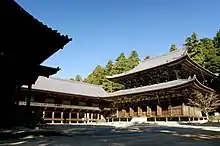| Shoshazan Engyō-ji | |
|---|---|
 One of the main buildings in the Shoshazan Engyoji Temple complex. | |
| Religion | |
| Affiliation | Tendai |
| Deity | Nyoirin Kannon (Cintamāṇicakra) |
| Location | |
| Location | 2968, Shosha, Himeji, Hyogo 671-2201 |
| Country | Japan |
| Geographic coordinates | 34°53′28″N 134°39′29″E / 34.891139°N 134.658139°E |
| Architecture | |
| Founder | Shoku |
| Completed | 966 |
| Website | |
| http://www.shosha.or.jp/ | |
The Shoshazan Engyō-ji (書写山圓教寺 or less commonly 書寫山圓教寺) is a temple of the Tendai sect in Himeji, Hyōgo, Japan.
History
It was founded by Shoku Shonin in 966.
The complex of buildings is at the top of Mt Shosha approximately 25 minutes by bus from Himeji Station. The mountain summit can be reached by either a one-mile hiking trail or Mt. Shosha Ropeway, and is often visited by pilgrims. Scenes from The Last Samurai were filmed there.
Engyō-ji is temple No. 27 in the Kansai Kannon Pilgrimage, following Ichijō-ji and preceding Nariai-ji.
Building list
- Bentendō
- Daikōdō - Important Cultural Property of Japan. It was rebuilt in Muromachi period.
- Daikokudō
- Fudōdō
- Gohōdō - Important Cultural Property of Japan. It was rebuilt in 1559.
- Gohōdō haiden - It was rebuilt in 1589.
- Gyōjadō
- Hokkedō
- Jikidō - Important Cultural Property of Japan. It was rebuilt in Muromachi period.
- Jōgyōdō - Important Cultural Property of Japan. It was rebuilt in Muromachi period.
- Jujiin
- Jumyōin - Kyakuden, Kuri and Karamon is Important Cultural Property of Japan.
- Juryōin - Important Cultural Property of Japan.
- Kaizandō - Important Cultural Property of Japan. It was rebuilt in Edo period.
- Kongodō - Important Cultural Property of Japan. It was rebuilt in Muromachi period.
- Maniden - It was rebuilt in 1933.
- Monjudō
- Myōkōin
- Sengakuin
- Shōrō - Important Cultural Property of Japan. It was rebuilt in Kamakura period.
- Yakushidō
- Zuikōin
 Maniden
Maniden Jikidō
Jikidō Shōrō
Shōrō Jyōgyōdō
Jyōgyōdō
 Mount Shosha Ropeway
Mount Shosha Ropeway
In media
Engyō-ji was one of the locations of the movie the Last Samurai. In the picture it is the temple of Lord Katsumoto.[1]
It was also one of the filming locations of Snake Eyes.[2][3]
See also
- For an explanation of terms concerning Japanese Buddhism, Japanese Buddhist art, and Japanese Buddhist temple architecture, see the Glossary of Japanese Buddhism.
References
- ↑ "Engyoji Temple – The Last Samurai's Winter Hideaway". www.japan-guide.com/. Retrieved 30 September 2022.
- ↑ IT, SCEEN. "Snake Eyes: G.I. Joe Origins at Kishiwada Castle - filming location". www.sceen-it.com.
- ↑ Mukhopadhyay, Arka (22 July 2021). "Where Was Snake Eyes (2021) Filmed?".
External links
Wikimedia Commons has media related to Engyō-ji.
- Hyogo Tourism - Engyoji
- Mt. Shosha - Engyoji (Japanese)
- Official Himeji tourism website in English
This article is issued from Wikipedia. The text is licensed under Creative Commons - Attribution - Sharealike. Additional terms may apply for the media files.